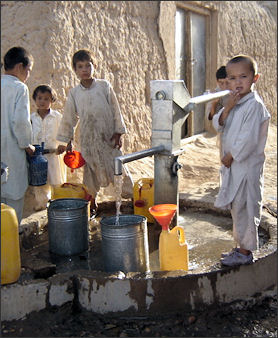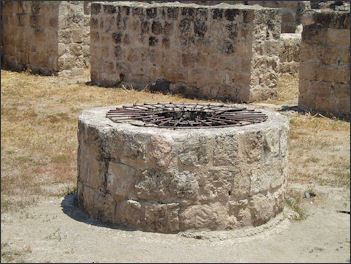WATER
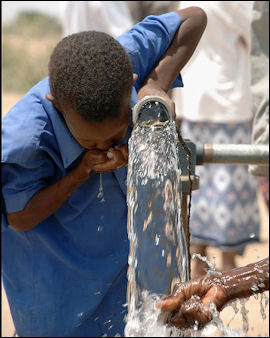
Only about one percent of the world’s fresh water is available for consumption by the world’s 6.6 billion people. Water makes up as much as 70 percent of our bodies and is necessary our most fundamental biological and chemical reactions. Every cell in the body needs water. People can rarely can for go for more than a week without water. The body needs to replace the liter or more it loses every day.
Only a fraction of one percent of the world’s water is available for drinking, bathing, agriculture and industry. About 96.5 percent of the world’s water is salt water in seas and oceans. Another once percent is salt water in lakes and brackish and salty groundwater. That means only 2.5 percent of the world’s water is fresh water. About 70 percent of the this is frozen in polar ice sheets and glaciers and around 29.5 percent is in deep, hard-to-reach aquifers.
Lakes and rivers contain just slightly more than one forth of a percent of all freshwater. Soils and wetlands, plants and animals contain less than a tenth of a percent. Clouds and atmospheric water vapor contain less than four one-hundredths of a percent. Much of the freshwater that is available flows into the seas are ends in places that people don’t need it, such as in Canada and Siberia.
Water is often treated like it is common property — free to use no matter what you do with it or how much you use. As a result huge amounts of it are wasted. Global water consumption grew sevenfold in the 20th century. As it stands now every one percent of population rise is accompanied by a two to three percent rise in water consumption. In March 2006, 12,000 delegates and representatives from 130 countries met in Mexico City to discuss water problems at the 4th International Water conference.
A poem by the late economist Kenneth Boulding goes:
Water is politics, water’s religion
Water is about everyone’s pigeon...
Water is tragical, water is comical.
Water is far from pure economical.
Uses of Water
tube well in Afghanistan People use water for drinking and hygiene. Around 20 to 50 liters a day per person is regarded as a minimum for basic needs such as drinking, cooking, bathing and sanitation (Americans consume between 400 and 600 liters a day). Far more is used by industry and in agriculture and food production.
About 70 percent of the water used worldwide is used for agriculture. In some developing countries the figure reaches 90 percent. It takes about 1400 liters of water to produce a kilogram of wheat; 2800 liters of water to produce a kilogram of rice; 14,000 liters of water to produce a kilogram of beef; and even more than that to produce a cotton T-shirt.. Industry uses another 22 percent. Only about 8 percent goes to personal use.
As development increases and more people eat meat and have access to flush toilets and showers, water consumption also rises. Raising a cow requires a thousand times more water than the equivalent amount of food in the form of grain.
Worldwide water use: 1) agriculture (70 percent); 2) industry (20 percent); and 3) domestic uses such as drinking, washing and flushing toilets (10 percent). Water has traditionally been a source of power and wealth in the developing countries. Powerful people often controlled wells and irrigation water.
Well water is much safer than pond or even river water. The ground the water passes through helps filter out germs and impurities. Some villagers complain that it tasteless and say they prefer pond water. Even when a well is ready to use villagers are reluctant to use it. Ponds are used for raising fish and supplying drinking water for animals and irrigation water for crops.
Aquifers and Fossil Water
a well Aquifers are underground layers of porous rock that contain water. Shallow aquifers can be replenished by rain. Deep aquifers can not be quickly replenished. By some estimates there is a 100 times more underground water than there is surface water in lakes and rivers — enough to support billions of people for centuries.
Much of the world’s water it is at depths of one kilometer or more — too deep to be extracted economically. Drawing too much from shallow aquifers caused environmental damage. Once the water is gone it takes a long time for it be replenished.
In the past drilling deep for water was not seriously considered because it was prohibitively expensive. But these days with water shortages and the rising value of water, drilling for water is being considered more seriously. In some places, geologists armed with same technology used in the oil industry — core drillers and seismographs — are exploring for water and massive underground mapping projects are being carried out to determines the size and amount of water deposits.
"Fossil" water is water that has been trapped underground in aquifers for thousands or even millions of years and often dates back to a period when there was more rainfall, rivers and freshwater lakes.
Extracting fossil water is like pumping oil. New drilling technology allows wells over three quarters of mile deep be dug. Water from this wells is so deep it comes to surface piping hot. Sometimes taking out too much water can cause damage. The water is pressured. Once it is removed its may cause the ground above it to subside and upset the geology in other ways. Like oil once fossil water is gone it is gone for good. .
Deep artesian wells can be dug where a rock structure hold water under pressure. In some oases an artesian spring flows to the surface through a crack in the rock.
Water and Daily Life
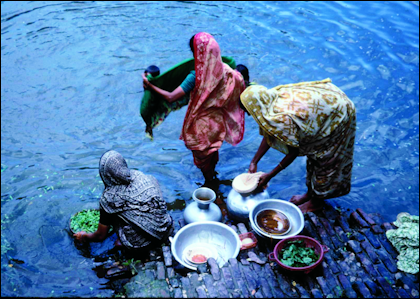
Only 10 percent of water worldwide is consumed for personal uses such as drinking, bathing and washing clothes and dishes. Each person needs about 48 liters (13 gallons of water) a day for drinking, cooking and sanitation. Even so, a sixth of world’s population gets by on less than that. Americans use an average of 400 liters of water per person per day. A lot this is water used for thing like irrigation and industry not just taking showers, washing cars and flushing toilets.
Most homes in the developing world don't have running water or toilets. In rural areas, water is often fetched and carried from wells and streams or even ponds. Urban poor get their water from community spigots. The water is often of dubious quality and dirty enough to make those who drink it get sick.
One of the primary responsibilities of village women and girls is making sure there is enough water for washing, cleaning, cooking and drinking. Women carry water from a communal well or stream to their homes everyday. Most of the time there is a well in the village. But not always. Sometimes women and girls walk several miles fetching water. One male villager told National Geographic, "Our women spend half their lives going for water."
Women often carry water on their head with a container balanced on a cloth wrapped in a circle on the top of their head. Experienced women can carry the load without using their hands. Less experienced women need to use their hands.
Village women seem to spend more time washing clothes by hand than doing anything else. From dawn to dusk the shores of lake and rivers are lined with women scrubbing, ringing and rinsing their families clothes. These women are also skilled at taking a baths in rivers and streams with their clothes on.
Many towns and villages have a collective washing area in the middle of town where women gather to do their laundry in cement sinks while chatting and telling stories. Rural people are very good at bathing in streams and rivers without removing their clothes.
In past villagers had to walk long distances to wells. Today, deep-boring machinery introduced by aid workers has enabled villages to have their own wells. One new water container design that seems to hold promise in the developing world is a wheel-like donut-shaped polyethylene water container that can hold 50 to 70 liters of water and can be easily pulled by a child with a string put through the hole of the container.
Fetching Water
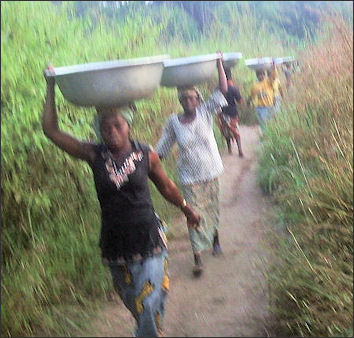
Reporting from southern Ethiopia, Tina Rosenberg wrote in National Geographic, “Aylito Binayo's feet know the mountain. Even at four in the morning she can run down the rocks to the river by starlight alone and climb the steep mountain back up to her village with 50 pounds of water on her back. She has made this journey three times a day for nearly all her 25 years. So has every other woman in her village of Foro, in the Konso district of southwestern Ethiopia. Binayo dropped out of school when she was eight years old, in part because she had to help her mother fetch water from the Toiro River. The water is dirty and unsafe to drink; every year that the ongoing drought continues, the once mighty river grows more exhausted. But it is the only water Foro has ever had. [Source: Tina Rosenberg, National Geographic, April 2010]
The task of fetching water defines life for Binayo. She must also help her husband grow cassava and beans in their fields, gather grass for their goats, dry grain and take it to the mill for grinding into flour, cook meals, keep the family compound clean, and take care of her three small sons. None of these jobs is as important or as consuming as the eight hours or so she spends each day fetching water.
Where clean water is scarcest, fetching it is almost always women's work. In Konso a man hauls water only during the few weeks following the birth of a baby. Very young boys fetch water, but only up to the age of seven or eight. The rule is enforced fiercely — by men and women. "If the boys are older, people gossip that the woman is lazy," Binayo says. The reputation of a woman in Konso, she says, rests on hard work: "If I sit and stay at home and do nothing, nobody likes me. But if I run up and down to get water, they say I'm a clever woman and work hard."
On a hot late afternoon I go with her to the river, carrying an empty jerry can. The trail is steep and in places slippery. We scramble down large rocks alongside cacti and thornbushes. After 50 minutes we reach the river — or what is a river at certain times of the year. Now it is a series of black, muddy pools, some barely puddles. The banks and rocks are littered with the excrement of donkeys and cows. There are about 40 people at the river, enough so that Binayo decides that the wait might be shorter upstream. The wait is especially long early in the morning, so Binayo usually makes her first trip before it is light, leaving her son Kumacho, a serious-faced little man who looks even younger than his four years, in charge of his younger brothers.
We walk another ten minutes upstream, and Binayo claims a perch next to a good pool, one fed not only by a dirty puddle just above but also a cleaner stream to the side. Children are jumping on the banks, squishing mud through their feet and stirring up the water. "Please don't jump," Binayo admonishes them. "It makes the water dirtier." A donkey steps in to drink from the puddle feeding Binayo's pool. When the donkey leaves, the women at the puddle scoop out some water to clear it, sending the dirty water down to Binayo, who scolds them.
After half an hour it is her turn. She takes her first jerry can and her yellow plastic scoop. Just as she puts her scoop in the water, she looks up to see another donkey plunk its hoof into the pool feeding hers. She grimaces. But she cannot wait any longer. She does not have the luxury of time. An hour after we arrive at the river, she has filled two jerry cans — one for her to carry back up, one for me to carry for her. She ties a leather strap around my can and puts it on my back. I am grateful for the smooth leather — Binayo herself uses a coarse rope. Still, the straps cut into my shoulders. The plastic can is full to the top, and the 50-pound load bounces off my spine as I walk. With difficulty, I make it halfway up. But where the trail turns steepest I can go no farther. Sheepishly, I trade cans with a girl who looks to be about eight, carrying a jerry can half the size of mine. She struggles with the heavier can, and about ten minutes from the top it is too much for her. Binayo takes the heavy jerry can from the girl and puts it on her own back, on top of the one she is carrying. She shoots us both a look of disgust and continues up the mountain, now with nearly 12 gallons of water — a hundred pounds — on her back.
Social and Economic Costs of Fetching Water
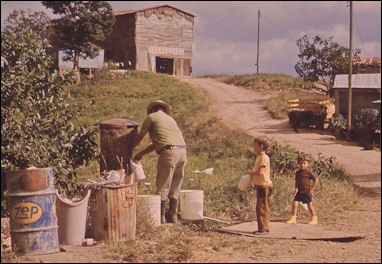
Tina Rosenberg wrote in National Geographic, “If the millions of women who haul water long distances had a faucet by their door, whole societies could be transformed... In much of the developing world, lack of water is at the center of a vicious circle of inequality. Some women in Foro come down to the river five times a day — with one or two of the trips devoted to getting water to make a beer-style home brew for their husbands. When I first came to Foro, some 60 men were sitting in the shade of a metal-roofed building, drinking and talking. It was midmorning. Women, says Binayo, "never get five seconds to sit down and rest." [Source: Tina Rosenberg, National Geographic, April 2010]
"When we are born, we know that we will have a hard life," Binayo says, sitting outside a hut in her compound, in front of the cassava she is drying on a goatskin, holding Kumacho, who wears no pants. "It is the culture of Konso from a long time before us." She has never questioned this life, never expected anything different. But soon, for the first time, things are going to change.
When you spend hours hauling water long distances, you measure every drop. The average American uses a hundred gallons of water just at home every day; Aylito Binayo makes do with two and a half gallons. Persuading people to use their water for washing is far more difficult when that water is carried up a mountain. And yet sanitation and hygiene matter — proper hand washing alone can cut diarrheal diseases by some 45 percent. Binayo washes her hands with water "maybe once a day," she says. She washes clothes once a year. "We don't even have enough water for drinking — how can we wash our clothes?" she says. She washes her own body only occasionally. A 2007 survey found that not a single Konso household had water with soap or ash (a decent cleanser) near their latrines to wash their hands. Binayo's family recently dug a latrine but cannot afford to buy soap.
How would Aylito Binayo's life be different if she never had to go to the river for water again? Deep in a gorge far from Foro, there is a well. It is 400 feet deep. During my visit it was nothing much to look at — aboveground it was only a concrete box with a jerry can inverted over it for protection, surrounded by a pyramid of bramble bushes. But here's what was to happen by March: A motorized pump would push the water up the mountain to a reservoir. Then gravity would carry it back down to taps in local villages — including Foro. The village would have two community taps and a shower house for bathing. If all went well, Aylito Binayo would have a faucet with safe water just a three-minute stroll from her front door.
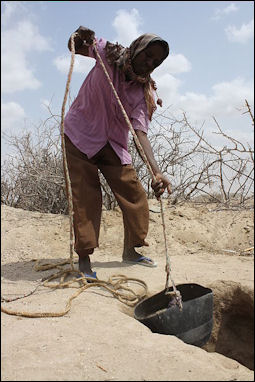
preparing a hole for a latrineWhen I ask her to imagine this easier life, she closes her eyes and reels off a long list of chores. She will go the fields to help her husband, collect grass for the goats, make food for her family, clean the compound. She will be with her sons, instead of leaving a grave little four-year-old in charge of his younger brothers for hours on end. "I don't know whether to believe it will work. We are on top of a mountain, and the water is down below," she says. "But if it works, I will be so happy, so very happy."
I ask her about her hopes for her family, and her answer is heartbreaking in its modesty: to get through the new hunger brought on by the drought, to get through this new wave of disease — to scramble back to the meager life she had known before. She doesn't dream. She has never dared think that someday life could change for the better — that there could arrive a metal spigot, out of the end of which gushed dignity.
Benefits of Clean Water and Sanitation
Tina Rosenberg wrote in National Geographic, “In wealthy parts of the world, people turn on a faucet and out pours abundant, clean water. Yet...2.5 billion people have no safe way to dispose of human waste — many defecate in open fields or near the same rivers they drink from. Dirty water and lack of a toilet and proper hygiene kill 3.3 million people around the world annually, most of them children under age five.
Bringing clean water close to people's homes is key to reversing a cycle of misery. Communities where clean water becomes accessible and plentiful are transformed. All the hours previously spent hauling water can be used to grow more food, raise more animals, or even start income-producing businesses. Families no longer drink microbe soup, so they spend less time sick or caring for loved ones stricken with waterborne diseases. Most important, freedom from water slavery means girls can go to school and choose a better life. The need to fetch water for the family, or to take care of younger siblings while their mother goes, is the main reason very few women in Konso have attended school. Binayo is one of only a handful of women I met who even know how old they are. [Source: Tina Rosenberg, National Geographic, April 2010]
Access to water is not solely a rural problem. All over the developing world, many urban slum dwellers spend much of the day waiting in line at a pump. But the challenges of bringing water to remote villages like those in Konso are overwhelming. Binayo's village of Foro sits atop a mountain. Many villages in the tropics were built high in the hills, where it is cooler and less malarious and easier to see when the enemy is coming. But Konso's mountaintop villages do not have easy access to water. Drought and deforestation keep pushing the water table lower — in some parts of Konso it is more than 400 feet belowground. The best that can be done in some villages is to put in a well near the river. The water is no closer, but at least it is reliable, easier to extract, and more likely to be clean.
Tube Wells and Treadle Pumps
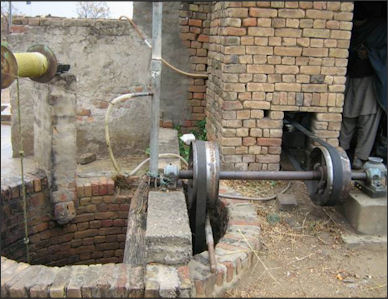
tube well A tube well is a type of well comprised of a relatively narrow cylinders sunk into the ground and a hand pump above ground. It taps into clean groundwater or natural aquifers. Tube wells can be dug very deep using technology similar to that used in the oil industry.
There is a concern that uncontrolled tube well use might lead to a water crisis. In some places farmers using tube wells with electric pumps are sucking up groundwater reserves much faster than can be replenished. Tens of thousands of these wells have been dug, often beyond official control. The problem is particularly acute in places where there is relatively little water and a particularly high number of people. In some cases the water is wasted nourishing water-thirsty crops like alfalfa, rice and sugar cane.
Pumps are important for irrigation. In the old days water wheels and manual labor were needed to lift water from wells, rivers, canals and ponds to agricultural land. Now gasoline- and diesel-powered pumps do much of the work. Pumps may be noisy but are a relatively cheap and efficient.
Studies in South Asia have shown that a traditional treadle water pump — operated by a person on a device that looks a bit like a Stairmaster stair climber — can increases the income of farmers by 25 percent. First introduced to Bangladesh in the 1980s and now widely used in Asia and sub-Sahara Africa, these pumps are easy to install and simple to operate and often deliver higher crops yields than those obtained using diesel pumps.
Treadle pumps are worked by people who step on pedals. They are used mostly to bring groundwater and well water to the surface to fill irrigation ditches in fields. NGOs involved in promoting the technology say they reduce poverty, improve agriculture and enable men to stay with their families rather than going off to the cities to work. Climate Care (See Below) is involved in promoting treadle pumps. It calculates that each one saves 0.66 tons of carbon dioxide a year, a figure arrived at mainly by calculating how greenhouse gases would be used were a diesel pump used.
Irrigation, Water and Agriculture
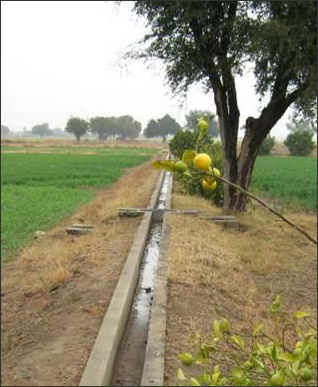
Drains for irrigation Agriculture accounts for 70 percent of all water use and irrigation grows 40 percent of the world’s food. In developing countries irrigation accounts for 80 percent of the water consumed. In places where irrigation doesn’t exist, if the rains fail, crops often fail.
Water for irrigation can come from wells, rivers, canals, lakes, ponds and reservoirs. Often dams are built to supply water for irrigation.
One woman farmer told the New York Times, “Now we can’t just depend on rain -fed agriculture, so we plant two crops — one watered with rain and one that needs irrigating. But irrigation is back-breaking and can take four hours a day.”
In desert regions spate irrigation is a system that diverts flood waters into dry areas. Used for thousands of years in the Middle East, North Africa, Pakistan, Mongolia and Latin America, it involves building dams from riverbed sand to channel flood waters into adjacent fields. The system require constant attention and maintenance as flood waters often overwhelm or damage it.
Efforts to replace spate irrigation with concrete dams often causes more harm than good because the flood deposits large amounts of sediment that clog the gates and canals.
Irrigation with canals is very inefficient. Lots of water is lost to evaporation, run offs and absorption into the soil.
See Separate Article DESERT AGRICULTURE AND IRRIGATION factsanddetails.com
Bottled Water
Worldwide 47 billion gallons (170 billion liters) of bottled water was sold in 2006, up from 43 billion gallons in 2005.
The bottled water market in the United States is the largest in the world. Sales reached 8.82 billion gallons, worth $11.7 billion, in 2007. In many cases the water is simply tap water that has been put through a couple of filters. Critics of bottled water object to: 1) the energy and petroleum used to make the bottles; 2) the cost and energy used to transport the water; and 3) the liter and pollution created by discarded plastic bottles.
In the United States the energy required to make water bottles is equivalent to 17 million barrels of oil a year. Globally, it is equivalent to about 100 million barrels annually.
Bottled water can be more than 1,000 times more expensive than tap water. The priciest stuff goes for around $500 a bottle, a million times more expensive than the stuff that from the tap.
Taste tests have consistently showed that people can rarely tell the difference between tap water and bottled water or distinguish between different kinds of bottled water. Richard Will, an anthropology professor at Indiana University, told the Washington Post, “taste for water is as much an effort of imagination as it is an objective tests.”
Hydropower and Dams
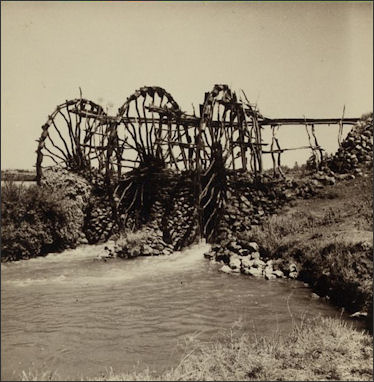
Assyrian irrigation watermills Dams have been built to control flooding, improve transportation, generate electricity and provide water for irrigation and other uses. The world’s 45,000 large dams catch 14 percent of all precipitation runoff, provide water for up to 40 percent of irrigated land and give 65 countries more than half of their electricity. In many places, hydropower from dams has largely topped out. Many proposed projects will either cause severe environmental problems and/or require the relocation of huge numbers of people.
Hydropower is criticized from disrupting river ecology and uprooting populations. Large numbers rural people have lost their homes as a result of hydroelectric dam projects. Some have been evicted from their land and received little or no compensation. Without a means of making a living, many of the displaced people migrate to the cities. Hydropower is making a comeback as a green energy source that produces few greenhouse-gas emissions. Or is that really the case? Research by Philippe Feranside of hydro project in the Amazon found that dam reservoirs submerge large amounts of plants and soil and as it does releases large amounts of carbon dioxide and methane and the plants are lost as carbon consumers. Many of the gases that are locked up in the reservoir water are released when they pass through the turbines.
A number of countries have had success with microhydroelectric plants. The systems — set up with support of local people — divert waters from streams and rivers to run turbines with complex dams and catchment areas. Plants produce up to 200 kilowatts, enough to provide electricity for 200 to 500 homes.
Image Sources: Wikimedia Commons
Text Sources: New York Times, Washington Post, Los Angeles Times, Times of London, Yomiuri Shimbun, The Guardian, National Geographic, The New Yorker, Time, Newsweek, Reuters, AP, Lonely Planet Guides, Compton’s Encyclopedia and various books and other publications.
Last updated April 2022

